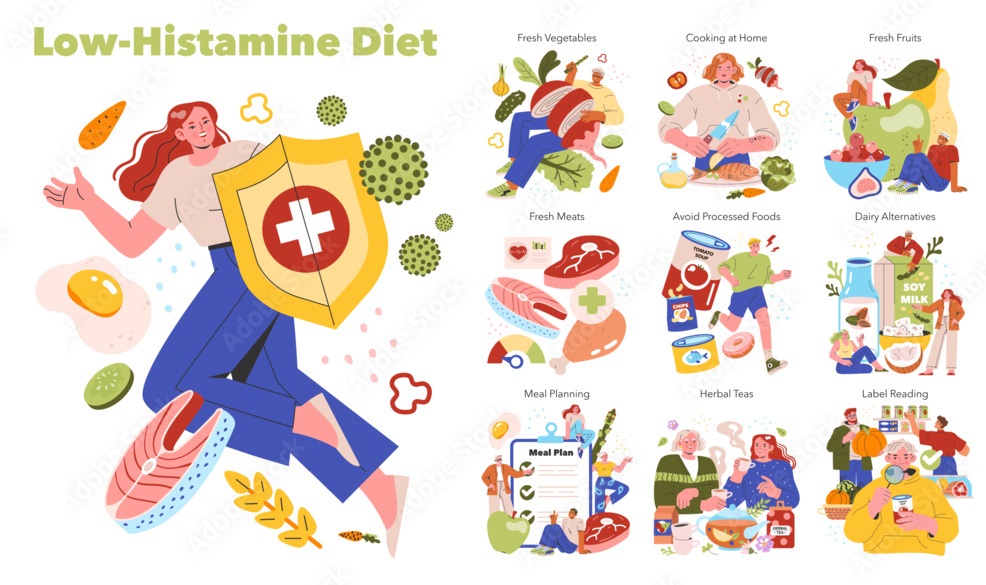Ever felt like your body is rebelling against you with unexplained digestive issues, headaches, or skin problems? You’re not alone. Many people have stumbled upon the low-histamine diet as a potential solution. But is this diet the answer to your problems? Let’s dive into what a gastroenterologist has to say about it.
Understanding Histamine and Its Role
Histamine is like a multitasking employee in your body, handling everything from immune responses to digestion and even sending messages between your brain and the rest of your body. It’s naturally found in various foods, especially those that are aged, fermented, or processed. While histamine is essential for good health, too much of it can be a bad thing.
Histamine Intolerance: A Real Concern?
Histamine intolerance happens when there’s more histamine in your body than it can handle. This imbalance often occurs due to a shortage of an enzyme called diamine oxidase (DAO), which is responsible for breaking down histamine in your gut. If your body can’t break down histamine properly, you might experience:
- Headaches or migraines
- Bloating, diarrhea, or stomach pain
- Skin issues like hives or eczema
- Nasal congestion or sinus problems
- Fatigue
What is a Low-Histamine Diet?
A low-histamine diet means cutting back on foods that are high in histamine to help manage these symptoms. Common foods to avoid include:
- Fermented foods (think sauerkraut, yogurt, soy sauce)
- Aged cheeses
- Cured meats
- Alcohol
- Certain fish (like tuna, mackerel, sardines)
- Vinegar-containing products (pickles, mayonnaise)
- Some fruits and vegetables (such as tomatoes, eggplants, avocados)
What a Gastroenterologist Says?
Dr. Jane Smith, a seasoned gastroenterologist, believes that the low-histamine diet can be a lifesaver for those with histamine intolerance. “Histamine intolerance isn’t widely recognized, but it can greatly impact a person’s quality of life. A low-histamine diet can help manage symptoms, but it’s important to do it correctly and with professional guidance,” she says.
Dr. Smith’s Tips for Navigating a Low-Histamine Diet:
- Consult a Healthcare Professional: Always check in with a healthcare provider before starting any new diet, especially one as specific as the low-histamine diet. They can help confirm if you have histamine intolerance and guide you on how to follow the diet safely.
- Keep a Food Diary: Note what you eat and any symptoms you experience. This helps in identifying which foods might be causing issues.
- Gradual Elimination and Reintroduction: Begin by removing high-histamine foods from your diet, then slowly reintroduce them one at a time to see which ones trigger symptoms.
- Balance Your Diet: Ensure you’re still getting a variety of nutrients. Since this diet can be quite restrictive, focus on fresh, unprocessed foods like lean meats, fresh fruits, and vegetables.
- Consider Supplements: Some people might benefit from DAO supplements, which help break down histamine in the gut. Discuss this option with your healthcare provider.
Is the Low-Histamine Diet for You?
If you think you might have histamine intolerance, a low-histamine diet could be worth exploring. But remember, it’s essential to do it with the guidance of a healthcare professional. While this diet can be very effective for managing symptoms, it’s not a one-size-fits-all solution. Proper diagnosis and personalized advice are key to ensuring your dietary needs are met.
Conclusion:
The low-histamine diet can be a game-changer for those struggling with histamine intolerance. By reducing high-histamine foods and keeping track of your symptoms, you might find the relief you’ve been searching for. However, don’t go it alone—professional guidance is crucial to ensure you’re doing it right and staying healthy.
Have you tried a low-histamine diet? Share your experiences and tips in the comments below!
